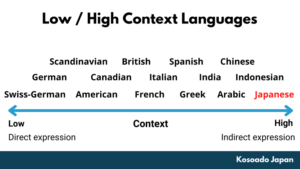Navigating Low-Context and High-Context Communication Challenges
In our increasingly interconnected world, international projects have become the norm, offering endless opportunities for collaboration across cultures and borders. However, with these opportunities come unique challenges, particularly in the realm of communication. This article delves into the concept of low-context and high-context communication, explores the challenges project managers face when dealing with these distinct communication styles, and offers strategies to effectively navigate these hurdles.

Understanding Low-Context and High-Context Communication:
Before we dive into the challenges and solutions, it is essential to understand the fundamental differences between low-context and high-context communication.
- Low-Context Communication: In low-context cultures, such as North America and Western Europe, communication is direct, explicit, and relies heavily on verbal and written language. Information is spelled out in detail, leaving little room for ambiguity or assumptions. People expect clarity and often prioritize the message itself over the context in which it is conveyed.
- High-Context Communication: In high-context cultures, prevalent in Asian, Middle Eastern, and some Latin American countries, communication is more implicit and relies on shared context, nonverbal cues, and indirect language. Much of the information is understood implicitly, and words are used more sparingly. People place great importance on the context surrounding the message, such as the relationship between the communicators and the situational cues.
Challenges Faced by Project Managers:
- Misinterpretation and Ambiguity: Project managers operating in diverse cultural environments may find it challenging to interpret messages accurately due to differing levels of context. High-context communicators may assume that others understand subtle cues, leading to misunderstandings and misaligned expectations.
- Direct vs. Indirect Communication: Project managers accustomed to low-context communication styles might encounter challenges when working with high-context communicators who prefer indirect or vague language. Reading between the lines becomes crucial in such interactions.
- Decision-Making Processes: High-context cultures often prioritize building relationships and consensus before making decisions. This can lead to slower decision-making processes, which may be frustrating for project managers accustomed to the efficiency of low-context cultures.
- Communication Overload or Silence: Project managers from low-context cultures may face a constant flow of information, updates, and questions, while those in high-context cultures may exhibit communication restraint, leading to project managers feeling left in the dark or struggling to obtain critical information.
- Building Trust and Relationships: High-context cultures place significant emphasis on building personal relationships and trust before engaging in business. Project managers may need to invest more time and effort into relationship-building to foster effective collaboration.
Some solutions and Approaches:
- Awareness and Education: Project managers should proactively educate themselves and their teams about the cultural communication norms of their international partners. Understanding the differences between low and high-context cultures can help mitigate potential issues.
- Encourage Open Communication: Foster an environment where team members feel comfortable expressing themselves openly. Encourage high-context communicators to share their thoughts explicitly, and guide low-context communicators to recognize and appreciate nonverbal cues.
- Adaptability and Flexibility: Successful project managers are adaptable and willing to adjust their communication styles based on the cultural context of their team members. Being open to different approaches fosters a more inclusive work environment.
- Utilize Technology: Embrace collaboration tools, project management software, and video conferencing to bridge communication gaps. Technology can help ensure everyone stays informed, regardless of their cultural communication preferences.
- Cross-Cultural Training: Offer cultural sensitivity training for project team members to develop cross-cultural communication skills and improve intercultural understanding. Encourage an ongoing dialogue about communication styles and cultural differences to enhance teamwork.
Navigating the challenges of low-context and high-context communication is crucial for the success of international projects. By cultivating cultural awareness, embracing adaptability, and fostering transparent communication, project managers can build cohesive, high-performing teams that thrive in a globalized world. Embracing the uniqueness of each team member and recognizing the value of diverse perspectives will not only lead to successful project outcomes but also foster meaningful relationships that extend beyond the boundaries of the project itself.
